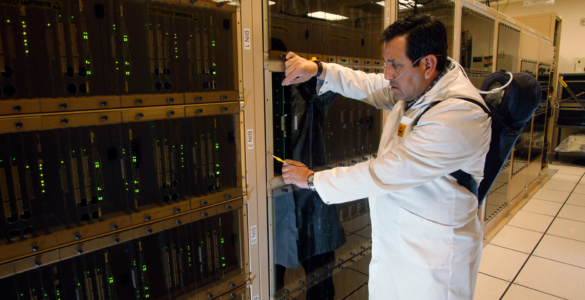Latest NRAO News
News is managed by NRAO News & Public Information. Questions about News? Have a story to share? Want to interview a scientist or create new media about our telescopes?

On March 13th, 2023, astronomers around the world will mark the 10th anniversary of the inauguration of the Atacama Large Millimeter/submillimeter Array (ALMA), the world’s largest radio telescope. Over the past decade, the international ALMA collaboration— led by the U.S. National Science Foundation’s National Radio Astronomy Observatory (NRAO), the European Southern Observatory (ESO), and the National Astronomical Observatory of Japan (NAOJ)— has revolutionized our understanding of the Universe and unveiled its secrets, from the formation of planets, stars, and galaxies to deciphering the chemistry of the cosmos, and even taking part in capturing the first images of black holes.

Scientists studying a nearby protostar have detected the presence of water in its circumstellar disk. The new observations made with the Atacama Large Millimeter/submillimeter Array (ALMA) mark the first detection of water being inherited into a protoplanetary disk without significant changes to its composition. These results further suggest that the water in our Solar System formed billions of years before the Sun. The new observations are published today in Nature.

While studying galaxies in the early Universe with the Atacama Large Millimeter/submillimeter Array (ALMA), scientists discovered one of the most extreme galaxies ever recorded in the early Universe. What’s more, it was hiding a unique supermassive black hole (SMBH). The observations could unlock clues about the early formation of these violent giants and how to find them.

The Board of the Atacama Large Millimeter/submillimeter Array (ALMA)— an international collaboration in which the National Science Foundation’s National…

The Universe is a dynamic and exciting place, with stars, planets, and galaxies being born, dying, and undergoing dramatic changes. In 2022, the telescopes of the National Science Foundation’s National Radio Astronomy Observatory (NRAO) revealed fascinating new details about several of these processes, and we’re giving you a taste of the greatest radio astronomy moments of the year.

While studying a nearby pair of merging galaxies using the Atacama Large Millimeter/submillimeter Array (ALMA)— an international observatory co-operated by the U.S. National Science Foundation’s National Radio Astronomy Observatory (NRAO)— scientists discovered two supermassive black holes growing simultaneously near the center of the newly coalescing galaxy. These super-hungry giants are the closest together that scientists have ever observed in multiple wavelengths. What’s more, the new research reveals that binary black holes and the galaxy mergers that create them may be surprisingly commonplace in the Universe. The results of the new research were published today in The Astrophysical Journal Letters, and presented in a press conference at the 241st meeting of the American Astronomical Society (AAS) in Seattle, Washington.

While using the Atacama Large Millimeter/submillimeter Array (ALMA) to study the masers around oddball star MWC 349A scientists discovered something unexpected: a previously unseen jet of material launching from the star’s gas disk at impossibly high speeds. What’s more, they believe the jet is caused by strong magnetic forces surrounding the star. The discovery could help researchers to understand the nature and evolution of massive stars and how hydrogen masers are formed in space. The new observations were presented today in a press conference at the 241st meeting of the American Astronomical Society (AAS) in Seattle, Washington.

Shockwaves resulting from the violent collision between an intruder galaxy and Stephan’s Quintet are helping astronomers to understand how turbulence influences gas in the intergalactic medium. New observations with the Atacama Large Millimeter/submillimeter Array (ALMA) and the James Webb Space Telescope (JWST) have revealed that a sonic boom several times the size of the Milky Way has kickstarted a recycling plant for warm and cold molecular hydrogen gas. What’s more, scientists uncovered the break-up of a giant cloud into a fog of warm gas, the possible collision of two clouds forming a splash of warm gas around them, and the formation of a new galaxy. The observations were presented today in a press conference at the 241st meeting of the American Astronomical Society (AAS) in Seattle, Washington.

Forty-eight days after suspending observations due to a cyberattack, the Atacama Large Millimeter/submillimeter Array (ALMA) is observing the sky again. The computing staff has worked diligently to rebuild the affected JAO computer system servers and services. This is a crucial milestone in the recovery process.

VLA teams up with Juno spacecraft to study Jupiter’s atmosphere, and ALMA reveals new details about Io’s volcanoes.





